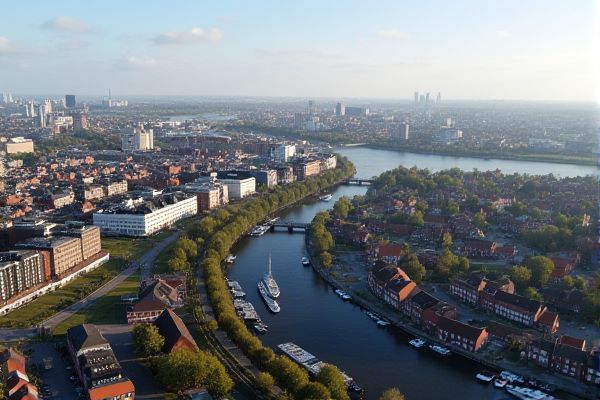
Dining and food culture in Denmark: Emphasis on seasonal ingredients. Smorrebrod is a traditional dish. Hygge involves cozy dining experiences. Lunch is usually cold and quick. Dinner often starts around 6 PM. Danish pastries are popular snacks. Tap water is safe to drink. Many vegan and vegetarian options available. Restaurant tipping is not customary. Alcohol is expensive but widely consumed.
Emphasis on seasonal ingredients.
Danish cuisine is renowned for its strong emphasis on using seasonal ingredients, drawing inspiration from traditional Nordic culinary practices. These traditions include techniques such as curing, pickling, and making jams, all designed to ensure food preservation through the harsh winter months. In Danish food culture, the importance of seasonal ingredients is prominently highlighted in dishes like smørrebrød. This open-faced sandwich often features ingredients that are in season, such as new potatoes, which are celebrated during the months of June and July. Eating according to the season is highly valued in Denmark, not only for its ability to ensure a more flavorful and nutritious experience but also because it is more economical and environmentally friendly. This practice places a focus on locally sourced and organic produce, which enhances the sustainability of the cuisine. For more insights into these cherished food traditions, visit the Traditional Danish Food website.
Smørrebrød is a traditional dish.
Smorrebrod, or Danish open sandwiches, are a staple of Danish cuisine, traditionally consisting of dense, dark rye bread (rugbrod) topped with various ingredients such as cold cuts, meat, fish, cheese, and spreads, often including locally available products like smoked salmon, herring, and egg. To explore more about this delightful traditional dish, you can visit the comprehensive guide on Caroline's Cooking, where you'll find insights into its preparation and cultural significance.
Hygge involves cozy dining experiences.
Hygge in Danish dining involves creating cozy and intimate experiences, often characterized by candle-lit spaces, sharing plates, and social settings that foster a sense of togetherness and comfort. This concept emphasizes the enjoyment of slow, homemade, and rustic foods in a relaxed and informal atmosphere. For more insights on experiencing hygge through dining, consider exploring Copenhagen's Ideal Spots for Candle-Lit Dinners, where you'll find the perfect blend of ambiance and traditional flavors.
Lunch is usually cold and quick.
Lunch in Denmark is typically a cold and quick meal, often consisting of open sandwiches known as Smorrebrod, which are prepared with rye bread and topped with cold meat, sliced sausage, hard-boiled egg, or other simple ingredients, and are commonly eaten at work or school. For more in-depth information about this traditional cuisine, you can explore the wide array of practices and dishes on Danish Cuisine, which further showcases the culinary heritage of Denmark and how it has been cherished over the years.
Dinner often starts around 6 PM.
In Denmark, dinner typically starts between 5:30 PM and 8:30 PM, with the norm being closer to the earlier side of this range, emphasizing family time and socializing. This cultural tradition underscores the importance of gathering with loved ones to share meals and enjoy each other's company. To understand more about Danish customs and when to appropriately greet someone in Denmark, explore this insightful article on All Things Denmark.
Danish pastries are popular snacks.
Danish pastries are deeply ingrained in Danish culture, often enjoyed as a routine start to the day or as an afternoon snack. These delightful treats are characterized by their flaky, layered textures and traditional fillings such as cinnamon, custards, and jams, which evoke a sense of nostalgia and community. For more insights into this global obsession, explore the world of Danish pastries at Copenhagen Bakeries.
Tap water is safe to drink.
In Denmark, tap water is generally safe to drink, sourced from naturally purified and filtered groundwater, with rigorous standards similar to those for bottled water. However, there are some concerns about nitrates and the occasional use of chlorine in certain areas. For more detailed information on the topic, you can visit the Tapp Water website. Overall, the country's commitment to maintaining high water quality is evident in its approach to water treatment and safety.
Many vegan and vegetarian options available.
Denmark offers a growing number of vegan and vegetarian options, with specialty restaurants like Cafe Kosmos, Restaurant Ark, and VeVe, as well as chains like Sticks'n'Sushi, providing a wide range of plant-based dishes, especially in major cities like Copenhagen and Aarhus. For more information, you can explore the variety of options available on the Visit Denmark website, which highlights the vibrant culinary scene in these areas.
Restaurant tipping is not customary.
Tipping in Denmark is not expected, as a service charge is normally included in the bill, and service staff enjoy relatively good wages, making additional tips unnecessary but appreciated for exceptional service. For more details on how to handle tipping while traveling in Denmark, you can visit the Tip Calculator provided by Wise. Understanding the local customs can enhance your travel experience and ensure that you navigate tipping practices respectfully and effectively.
Alcohol is expensive but widely consumed.
In Denmark, despite alcohol being expensive, it is widely consumed and deeply integrated into the culture. The high consumption rates are normalized across generations and associated with social enjoyment and cohesion. However, it also poses significant health and social risks. For more insights, explore this Anthology on Alcohol Culture in Denmark which delves into these dynamics.
